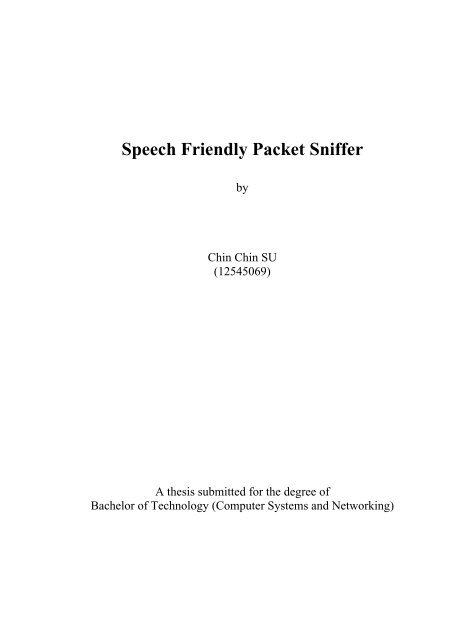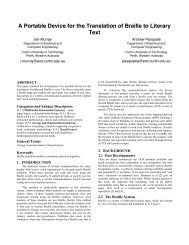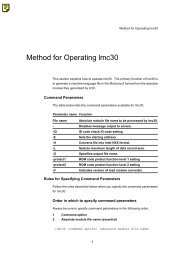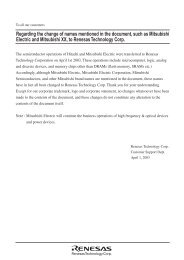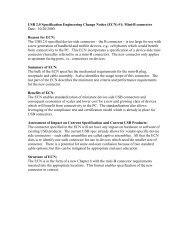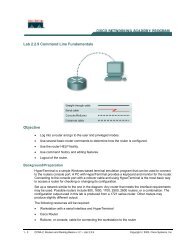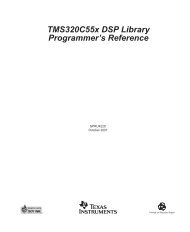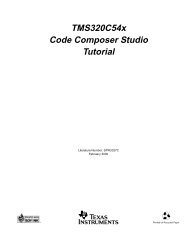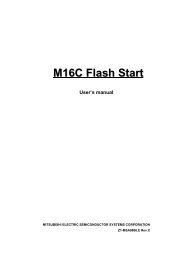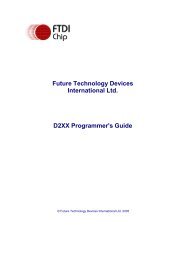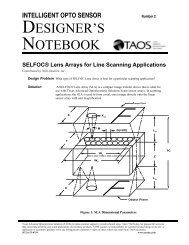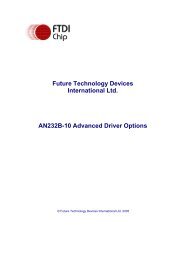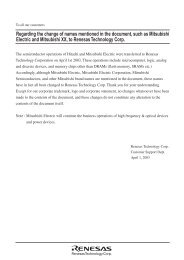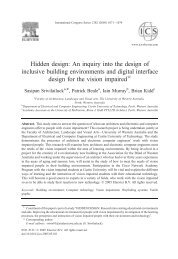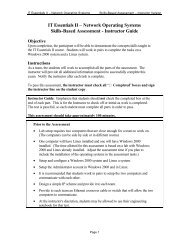Title Page - Curtin University Centre for Accessible Technology
Title Page - Curtin University Centre for Accessible Technology
Title Page - Curtin University Centre for Accessible Technology
You also want an ePaper? Increase the reach of your titles
YUMPU automatically turns print PDFs into web optimized ePapers that Google loves.
Speech Friendly Packet SnifferbyChin Chin SU(12545069)A thesis submitted <strong>for</strong> the degree ofBachelor of <strong>Technology</strong> (Computer Systems and Networking)
5/72 Kooyong rd.RIVERVALE WA 610315 November 2004Professor Syed IslamHead of DepartmentSchool of Electrical and Computer Engineering<strong>Curtin</strong> <strong>University</strong> of <strong>Technology</strong>Kent StreetBENTLEY WA 6102Dear Sir,I am pleased to submit this thesis entitled “Speech Friendly Packet Sniffer” as part ofthe requirements <strong>for</strong> the degree of Bachelor of <strong>Technology</strong> in Computer Systems andNetworking.I declare that this is my own work and have not been provided to other people.Sincerely Yours,Chin Chin SU
SYNOPSISThis thesis outlines the integration of the ethereal packet sniffer with Gnopernicusand GNOME libraries. It also outlines the testing and analysis of the final product,which is an ethereal packet sniffer that allows blind and visually impaired users touse it.Ethereal packet sniffer was chosen because it is open source and it is usedworldwide. Its source code is free and thus can be modified. Gnopernicus screenreader, which comes with Fedora Linux core 1 package, is incorporated with Festivalspeech synthetisers to allow sound output from the ethereal.i
ACKNOWLEDGEMENTSI would like to thank the following people:• Mr. Iain Murray, my project supervisor, <strong>for</strong> his constant guidance, supportand help throughout the course of this project,• Mr. Alex Wong, my Cisco lab tutor, <strong>for</strong> his help in Gnopernicus and FedoraLinux installation, also in introducing Glade,• Rudy Lee, my friend, <strong>for</strong> his help in integrating Ethereal source code withGnopernicus and GNOME libraries,• Silverio Armani, my boyfriend, <strong>for</strong> his help in debugging Ethereal sourcecode,• Leslie Riach, my good friend, and Lichen Su, my sister, <strong>for</strong> their help inediting my thesis.I appreciate their patience, experience and understanding towards the completion ofthis project.ii
NOMENCLATUREABWACAVIGNOMEAssociation <strong>for</strong> the Blind of Western AustraliaCisco Access <strong>for</strong> the Vision-ImpairedGNU Object Model Environment; it is a free desktop environment <strong>for</strong>UNIX and UNIX-like operating systemsGNUGNU's not UNIX; refers generally to software distributed under GPL(Mcarty, 1999)GPLGNU Public License. It provides <strong>for</strong> free access to software publishedunder its terms. Users are allowed to copy, modify, and redistributeGPL software (Mcarty, 1999)GTKGUITCP/IPGIMP Tool Kit. It is a multi-plat<strong>for</strong>m toolkit <strong>for</strong> creating GUI.Graphical User InterfacesTransmission Control Protocol / Internet Protocol; a standard methodof sending data packets across a computer network, focused on therouting and connection issues (Mcarty, 1999)TTSText To Speech; it is a type of speech synthesis application that isused to create a spoken sound version of the text in a computerdocument, such as a help file or a web page. TTL is often used withvoice recognition programs (Sticha, n.d)WidgetsA data structure that normally includes in<strong>for</strong>mation about a userinterfacecomponent (like a button or an edit box) and has pointers tothe code needed to make the component work (USGS, 2004)iii
TABLE OF CONTENTSSYNOPSIS ...................................................................................................................IACKNOWLEDGEMENTS...................................................................................... IINOMENCLATURE.................................................................................................IIILIST OF FIGURES .................................................................................................. VLIST OF TABLES ...................................................................................................VI1.0 INTRODUCTION.......................................................................................... 12.0 COMPUTER TECHNOLOGY AVAILABLE FOR THE VISUALLYIMPAIRED ................................................................................................................. 32.1 OVERVIEW .................................................................................................... 32.2 ASSISTIVE TECHNOLOGY FOR THE VISUALLY IMPAIRED............................... 43.0 PACKET SNIFFERS................................................................................... 113.1 OVERVIEW .................................................................................................. 113.2 ETHEREAL................................................................................................... 113.3 KSNIFFER.................................................................................................... 143.4 IPGRAB ....................................................................................................... 153.5 IPLOG.......................................................................................................... 164.0 DEVELOPING A SPEECH FRIENDLY PACKET SNIFFER .............. 174.1 PACKET SNIFFER SELECTION....................................................................... 174.2 SCREEN READERS ANALYSIS ...................................................................... 174.3 ETHEREAL SOURCE CODE INTEGRATION..................................................... 185.0 ETHEREAL TESTING............................................................................... 215.1 RESULTS OF TESTING .................................................................................. 215.2 EFFECTIVENESS OF THE SPEECH-FRIENDLY ETHEREAL................................ 226.0 CONCLUSION............................................................................................. 237.0 FUTURE WORK ......................................................................................... 248.0 REFERENCES............................................................................................. 25APPENDIX ............................................................................................................... 28GNOPERNICUS INSTALLATION................................................................................. 28FESTIVAL INSTALLATION ........................................................................................ 30ETHEREAL INSTALLATION ON WINDOWS ................................................................ 32ETHEREAL INSTALLATION ON LINUX ...................................................................... 32iv
LIST OF FIGURESFigure 1: Screen Magnification.................................................................................... 4Figure 3: Braille Display.............................................................................................. 5Figure 4: JAWS 5.0 (demo version) ............................................................................ 7Figure 5: Virgo 4.4 (demo version) ............................................................................. 7Figure 6: Gnopernicus screen reader <strong>for</strong> GNOME desktop......................................... 8Figure 7: Ethereal packet sniffer display ................................................................... 13Figure 8: KSniffer display.......................................................................................... 14v
LIST OF TABLESTable 1: Screen readers available <strong>for</strong> Windows and Linux ......................................... 6Table 2: Gnopernicus screen reader product in<strong>for</strong>mation............................................ 9vi
1.0 INTRODUCTIONComputer networking has advanced greatly and so has the technology used to accesspeople’s internal networks. Nowadays, tools like packet sniffers, network analysers,packet replays and denial of service attack scripts are very common. As such,network administrators are faced with the challenge of trying to secure theirnetworks from both internal and external intruders.Packet sniffer, <strong>for</strong> instance, can be used to troubleshoot a network problem bycapturing a packet and then analysing it. However, it can also be used to sniff apacket off from a network in order to obtain specific in<strong>for</strong>mation, such as usernameand password to gain unauthorised access to the network.With the increasing challenge to secure a network, it has become imperative toimplement good network security policies and have regular network monitoring at alltimes. It is important <strong>for</strong> anyone to be able to use the network security toolsavailable. This includes those with disabilities including visually impaired people.Cisco in conjunction with <strong>Curtin</strong> <strong>University</strong> and the Association <strong>for</strong> the Blind ofWestern Australia (ABWA) have created a program called Cisco Access <strong>for</strong> theVisually Impaired, CAVI, to assist visually impaired people to gain skills innetworking and computer technology (Waltner, 2003).This thesis aims to developing a speech friendly packet sniffer so that visuallyimpaired people are able to use it. It begins with an explanation of the existing1
assistive technologies available <strong>for</strong> visually impaired people. This is followed by anexplanation of what packet sniffers are. A comparison of some of the freely availablepacket sniffers is provided as well.An explanation as to why Ethereal and Gnopernicus are chosen is provided, and thisis followed by a discussion on the integration of the Ethereal with Gnopernicus.The thesis concludes with a description of the testing of the end product and theresults.2
2.0 COMPUTER TECHNOLOGY AVAILABLE FOR THE VISUALLYIMPAIRED2.1 OverviewToday’s computer technology relies heavily on sight <strong>for</strong> in<strong>for</strong>mation andcommunication. There<strong>for</strong>e, visually impaired people may have trouble usingtechnology and may feel isolated. For these reasons, tools have been created to assistthem.Braille presentation has become one of the dominant types of computer accessibilitymethods <strong>for</strong> the visually impaired. However, text in<strong>for</strong>mation on computer screenneeds to be translated into Braille alphabets and printed out. This process is slow andnot efficient. A real-time process would be preferred.Moreover, the computer cursor can be too small <strong>for</strong> visually impaired people and isnot accessible <strong>for</strong> the blind. There<strong>for</strong>e, the keyboard is an important tool <strong>for</strong> them <strong>for</strong>inputting data into the computer, navigating file directories and selecting icons.Hence, it is important to design software with keystroke accessibility; <strong>for</strong> instance,CTRL+O can be used to open a file in Microsoft Word.As a result, many companies such as Microsoft, Adobe and Macintosh haveintegrated accessibility, such as magnifier, narrator and on-screen keyboard, intotheir products. These allow increased accessibility <strong>for</strong> visually impaired people.3
2.2 Assistive <strong>Technology</strong> <strong>for</strong> the Visually ImpairedAssistive technology refers to technology that has been modified to assist individualswho have physical or cognitive difficulties, impairments or disabilities(http://www.microsoft.com/enable/at/types.aspx).Some examples of assistive technology <strong>for</strong> the visually impaired are screenmagnification, Braille presentation, screen readers and speech synthesisers.Screen magnification works like a magnifying glass. It enlarges screen text andgraphics to a size between 2 and 20 times their original sizes. Common examples areZoomtext, InLarge, Magic, Magnum Deluxe and Luna.Figure 1: Screen MagnificationBraille embossers print Braille on paper. Common brands are Everest, Versapoint,Thiel, Romeo, Bookmaker and Braille Express embossers.4
Figure 2: Braille EmbosserBraille displays are devices that convert text from the screen into Braille. They use aseries of electronic “pins” that are either in the up or down position, to represent theBraille characters so that blind and visually impaired people can read them. Commonmodels of Braille Display are Alva, Navigator, PowerBraille and Tieman ranges(DATWA, nd).Figure 3: Braille DisplayA screen reader is software that works together with a speech synthesizer to readaloud in<strong>for</strong>mation such as icons, menus, text, punctuation, and control buttons from acomputer screen. Table 1 lists a few screen readers running under Windows andLinux plat<strong>for</strong>ms.5
OperatingSystemWindowsScreenReaderHAL95, HALNTAvailability(Pricequoted inSeptember2004)Commercial(1,218 DM,1,856 DM)Windows Insight Commercial(around2000 DM)Windows Blindows Commercial(around1000 to4000 DM)Windows JAWS Commercial(2100 AU)Website/CompanyDolphin Computer AccessECO, BerlinFranc Audio Data(http://www.audiodata.de)Freedom Scientific(http://www.freedomscientific.com)Demo version can be downloadedwith restricted timing usage.Windows Virgo Commercial Demo version can be downloadedfrom www.virgo4.comLinux Gnopernicus Free Baum (http://www.baum.ro)Table 1: Screen readers available <strong>for</strong> Windows and LinuxA brief description of the screen readers that relate to this project is listed as follows:• JAWSJAWS stands <strong>for</strong> Job Access With Speech. It is a screen reader that reads andmagnifies in<strong>for</strong>mation in the computer screen. It not only outputs refreshableBraille displays but also provides unmatched Braille support to all screenreaders on the market (Freedom Scientific, 2003). It also supports manydifferent languages and most standard Windows applications without theneed to do special configuration, including Microsoft Office XP.6
Figure 4: JAWS 5.0 (demo version)• VirgoThis screen reader reads text from the screen and outputs it as speech via aspeech synthesizer or a sound card. It runs, however, only on Windowsplat<strong>for</strong>ms. The in<strong>for</strong>mation can be presented on a Braille display and outputusing a speech synthesizer. The display screen can be magnified to displaythe in<strong>for</strong>mation on the screen using the size and colours to meet the users’requirements. Figure 5 shows the main menu of Virgo 4.4 (demo version).Figure 5: Virgo 4.4 (demo version)7
• GnopernicusThis screen reader enables blind and visually impaired users to use GNOMEdesktop and Gnome/GTK+ applications effectively. GTK+ stands <strong>for</strong> GIMPTool Kit. It is a toolkit <strong>for</strong> creating graphical user interfaces (GUI) and offersa complete set of widgets. It is free software and part of the GNU project.Figure 6: Gnopernicus screen reader <strong>for</strong> GNOME desktopTable 2 provides more in<strong>for</strong>mation about Gnopernicus as extracted fromGnopernicus website.8
NameGnopernicusCurrent version (October 2004) 0.3.4Operating SystemLanguage versionsSpeech SynthetisersLinux, SolarisEnglish, German, SwedishFestival, Via Voice, FreeTTS, Dec-Talk(through gnome-speech)Braille devices supported VARIO20, VARIO40, VARIO80,DM80p, INKA ALVA 380, ALVA 544,ALVA 570 BRLTTY supported driversSound output deviceAll sound cards (supported by TTS)Table 2: Gnopernicus screen reader product in<strong>for</strong>mationSpeech synthesisers may be software or hardware and are used to convert screencontents into spoken words using synthetic speech. Some examples are:• FestivalIt is a speech synthesizer written in C++ that offers full text-to-speechconversion through a number of APIs. It was developed by the <strong>Centre</strong> <strong>for</strong>Speech <strong>Technology</strong> Research at <strong>University</strong> of Edinburgh. It provides abinding to the Java Speech API and is currently available in British andAmerican English, Spanish and Welsh. Other languages are in developmentand documentation on how to build new languages is available throughCarnegie Mellon’s FestVox project (http://festvox.org). Festival is free and itsspeech tools are distributed under an X11-type licence allowing unrestrictedcommercial and non-commercial use as such it is constantly being improved.9
• FreeTTSThis is another speech synthesizer that is written entirely in Java TMprogramming language. It is based upon a small run-time speech synthesisengine developed at Carnegie Mellon <strong>University</strong> called Flite. Flite is derivedfrom the Festival and FestVox projects. Building, running, and testingFreeTTS requires Java TM 2 SDK, Standard Edition, 1.4. FreeTTS is mainly inEnglish; however, it also supports a number of languages such as Spanish,Welsh and other languages, which can be imported from FestVox projectwebsite.• ViaVoiceThis is an IBM speech synthesizer. It is a commercial product running underWindows, Macintosh and handheld computer plat<strong>for</strong>ms. IBM offers manydifferent editions of ViaVoice to suit user’s needs such as ProUSB,Advanced, Standard and Personal edition <strong>for</strong> Windows plat<strong>for</strong>m, and MacOSX edition and Simply Dictation MacOS X edition <strong>for</strong> Macintosh plat<strong>for</strong>m.ViaVoice Standard edition offers features such as direct dictation intoMicrosoft Word products, Internet browser voice-command and creation ofcustomised dictation words, addresses and acronyms.10
3.0 PACKET SNIFFERS3.1 OverviewPacket sniffer is a dedicated device or software package designed <strong>for</strong> monitoringnetwork traffic in order to recognize and decode certain packets of interests (ATISCommittee T1A1, 2001). It is generally used by system administrators <strong>for</strong> networkmanagement and diagnostics. However, it can also be used by hackers to stealusernames, passwords and credit card numbers to make illegal purchases, captureand replay Voice over IP telephone conversations, map networks and so on.The issue of network security is beyond the scope of this thesis. This thesis mainlyfocuses on how to develop a speech friendly packet sniffer so that visually impairedpeople can use it to troubleshoot network problems and help to maintain networks.Packet sniffers are available freely and commercially. Descriptions to the freelyavailable packet sniffers are described next.3.2 EtherealEthereal is an open source packet sniffer that captures packets off the network,decodes them and presents them in a <strong>for</strong>mat that is easy to understand. It is mainlyused <strong>for</strong> analysing networking problems, such as unreachable network devices,denial of service, and so on.Ethereal has an easy to read and very configurable Graphical User Interface (GUI)with a rich display of filter capabilities such as tcpdump <strong>for</strong>mat capture filters. It is11
available in precompiled binaries and source code. It can be run on over 20 UNIXplat<strong>for</strong>ms such as IBM AIX, Linux, HP UX, OpenBSD and Solaris 8, and Windowsplat<strong>for</strong>ms such as Windows XP, Windows 2000, Windows NT and WindowsMe/98/95. However, it requires GTK+, GLIB and libpcap to run.Ethereal supports over 480 protocols. Because the source code is freely available, itis very easy <strong>for</strong> programmers to add new protocols to Ethereal, either as modules, orbuilt into the source. The version used <strong>for</strong> this project is 0.10.5.Figure 7 shows the Ethereal packet sniffer display window. This display windowconsists of three panes: summary, detail and data. The summary pane displays a onelinesummary of the capture. The detail pane provides all of the details of each of thelayers contained inside the captured packet in a tree-like structure and the data panedisplays the raw data captured in hexadecimal and ASCII <strong>for</strong>mat (Orebaugh et.al.,2004).12
SUMMARYDETAILtree-like structureDATAFigure 7: Ethereal packet sniffer displayThe detail pane provides detailed in<strong>for</strong>mation on a captured packet. One packet isselected in the summary pane in Figure 7, one at a time, by using a down arrow key.Its detailed in<strong>for</strong>mation can be obtained by using a ‘TAB” key to switch to the nextpane. A “SHIFT+TAB” key is used to switch to the previous pane. This is useful <strong>for</strong>blind and visually impaired people who cannot use mouse.A plus sign (+) in the detail pane is used to maximize the nested texts in the detailpane and a minus sign (-) to minimize them.13
3.3 KSnifferKSniffer is a network statistics collector (Donahoo, n.d.). It collects the number ofpackets and number of bytes <strong>for</strong> each protocol and displays the activity in terms ofKbits/s, Kbytes/s and packets/s. KSniffer supports most TCP/IP protocols such asTCP, IP, UDP, ICMP, ARP, RARP as well as minimal IPX. It can also be used towatch specific port traffic in monitoring network services such as http, ftp, andtelnet.A snapshot of the Ksniffer display with detailed interface statistics is provided inFigure 8. It contains fewer menu items and captures fewer protocols than Ethereal. Ingeneral, it is simpler than Ethereal.Figure 8: KSniffer display14
3.4 IpGrabIpGrab is a verbose packet sniffer that displays a great amount of detail on each ofthe packet it reads, including the application layer fields (SourceForge.net, 2004). Asample output is shown below (SourceForge.net, 2004).----------------------------------------------------------------Ethernet header (961445334.490653)----------------------------------------------------------------Hardware source: 00:10:4b:96:1d:a8Hardware destination: 08:00:02:25:29:77Protocol:0x800 (IP)Length: 68----------------------------------------------------------------IP Header----------------------------------------------------------------Version: 4Header length: 5TOS:0x10Total length: 54Identification: 6795Fragmentation offset: 0Unused bit: 0Don't fragment bit: 1More fragments bit: 0Time to live: 64Protocol:6 (TCP)Header checksum: 37890Source address: 149.112.60.156Destination address: 149.112.36.168----------------------------------------------------------------TCP Header----------------------------------------------------------------Source port:2692 (unknown)Destination port: 23 (telnet)Sequence number: 2876130028Acknowledgement number: 3994633468Header length: 8Unused: 0Flags:PAWindow size: 32120Checksum: 58743Urgent: 0Option:1 (no op)Option:1 (no op)Option:8 (timestamp)Length: 10Timestamp value: 181028495Timestamp reply: 44432019-----------------------------------------------------------------0D 00 ..15
And of a minimal mode TCP session:961445601.933843 00:10:4b:96:1d:a8->08:00:02:25:29:77 IP149.112.60.156->198.186.203.44 (72,DF) TCP 2690->22(PA,2794909852,2764779739,31856)961445602.086258 08:00:02:25:29:77->00:10:4b:96:1d:a8 IP198.186.203.44->149.112.60.156 (52,DF) TCP 22->2690(A,2764779739,2794909872,32120)961445602.086374 08:00:02:25:29:77->00:10:4b:96:1d:a8 IP198.186.203.44->149.112.60.156 (96,DF) TCP 22->2690(PA,2764779739,2794909872,32120)961445602.097106 00:10:4b:96:1d:a8->08:00:02:25:29:77 IP149.112.60.156->198.186.203.44 (52,DF) TCP 2690->22(A,2794909872,2764779783,31856)Unlike Ethereal and KSniffer that are GUI-based, IpGrab is text-based and runs onFreeBSD and Linux plat<strong>for</strong>ms only.3.5 IpLogIpLog is a TCP/IP traffic logger. It is used to monitor and log TCP, UDP and ICMPtraffic. It is also able to detect TCP port scans, TCP null scans, FIN scans, UDP andICMP "smurf" attacks, bogus TCP flags, TCP SYN scans, TCP "Xmas" scans, ICMPping floods, UDP scans and IP fragment attacks (McCabe, 2001).Similar to IpGrab, IpLog is text-based, but it can run on other plat<strong>for</strong>ms such asPOSIX BSD, FreeBSD, NetBSD, OpenBSD, POSIX IRIX, Linux and Sun OS /Solaris.16
4.0 DEVELOPING A SPEECH FRIENDLY PACKET SNIFFER4.1 Packet Sniffer SelectionEthereal was chosen among KSniffer, IpGrab and IpLog <strong>for</strong> this project because it isopen source, GUI-based, supports multiple protocols and plat<strong>for</strong>ms, provides morefeatures and is widely used.4.2 Screen Readers AnalysisJAWS is unable to read Ethereal because it is a commercially developed screenreader. Its source code is not available and thus it is almost impossible to know whatlibraries are required to be integrated into Ethereal to make it useable by JAWSscreen reader.Virgo is the Windows version of the Gnopernicus. It can read Ethereal but is not ableto read the Ethereal menus.Simultaneously running JAWS 4 and Virgo 4.4 causes the system to crash becauseVirgo 4.4 intercepted the video card and would not allow JAWS to use it. However,running a more recent version of JAWS (version 5) and Virgo 4.4 does not result insystem crash.Both Virgo and JAWS are not capable of reading Ethereal. JAWS could not readEthereal at all, while Virgo could not respond to the Ethereal menu widgets. Due tounavailability of both of the source codes, further investigation could not be carriedout at the time of this thesis.17
Gnopernicus is free and runs under Linux. The 0.3.4 version is used in this projectwith the Festival screen synthesizer. It is quite complicated to configure and buildbecause it requires many files with many dependencies. One file depends on manyother files. Gnopernicus and Festival installation steps and notes can be found in theAppendix.Gnopernicus is unable to read Ethereal as well. However, it could read otherGNOME/GTK+ applications, such as the Glade application that is part of FedoraLinux package. Next section will discuss how to make Gnopernicus reads Ethereal.4.3 Ethereal Source Code IntegrationEthereal source code is freely downloadable from its website(http://www.ethereal.com). Ethereal version 0.10.5 is used <strong>for</strong> this project.Gnopernicus has many dependencies/libraries. In order to read one application, itslibraries must be imported into the application. The CFLAGS in both Ethereal-0.10.5/Makefile and Ethereal-0.10.5/gtk/Makefile must be included in the following:CFLAGS = -DORBIT2=1 -pthread -I/usr/include/libgnomeui-2.0 -I/usr/include/libgnome-2.0 -I/usr/include/libgnomecanvas-2.0 -I/usr/include/gtk-2.0 -I/usr/include/libart-2.0 -I/usr/include/gconf/2 -I/usr/include/libbonoboui-2.0 -I/usr/include/glib-2.0 -I/usr/lib/glib-2.0/include -I/usr/include/orbit-2.0 -I/usr/include/libbonobo-2.0 -I/usr/include/gnome-vfs-2.0 -I/usr/lib/gnome-vfs-2.0/include -I/usr/include/bonobo-activation-2.0 -I/usr/include/pango-1.0 -I/usr/include/freetype2 -I/usr/lib/gtk-2.0/include -I/usr/include/atk-1.0 -I/usr/X11R6/include -I/usr/include/libxml2\-pthread -Wl,--export-dynamic -L/usr/X11R6/lib -lgnomeui-2 -lSM -lICE -lbonoboui-2 -lxml2 -lpthread -lz -lgnomecanvas-2 -lgnome-2 -lpopt -lart_lgpl_2 -lpangoft2-1.0 -lgtk-x11-2.0 -lgdk-x11-2.0 -latk-1.0 -lgdk_pixbuf-2.0 -lpangoxft-1.0 -lpangox-1.0 -lpango-1.0 -lbonobo-2 -lgconf-2 -lgnomevfs-2 -lbonobo-activation -lORBit-2 -lgobject-2.0 -lgthread-2.0 -lm -lgmodule-2.0 -ldl -lglib-2.018
Makefile is used to define a set of compilation rules. It contains comments,dependency lines, directories, macros, response files, rules and shell lines in order tocreate the executable file.A long line in a Makefile can be broken up by putting “\”as the last character of theline. For example,first_part_of_line second_part_of_lineis the same as:first_part_of_line \second_part_of_lineThe gnome header file, gnome.h, and gnome initialisation function(gnome_program_init) must also be included in main.c file located in ethereal-0.10.5/gtk.Gnome_program_init function is used to initialise the current GNOME libraries.Each application needs to call this function early in its lifetime. Users have to specifywhich modules should be initialised and if there is any special parameter value thatneeds to be passed on to the modules. The modules in this context refer to librariesneeded <strong>for</strong> the application, <strong>for</strong> example, libgnome_module or libgnomeui_module inGnopernicus.The following code is integrated into the Ethereal source code:in main.c file located in Ethereal-0.10.5/gtk/main.c:#include 19
in int main(int argc, char *argv[]) function:gnome_program_init ("ethereal", NULL, LIBGNOMEUI_MODULE,argc, argv,GNOME_PARAM_APP_DATADIR, NULL, NULL);As long as the above two lines of codes in bold are integrated in any GNOMEapplications, the program will be readable by Gnopernicus.Additonally, Ethereal must be configured and built every time it is modified. Thecommands “./configure”, “make” and “make install” are used <strong>for</strong> this purpose.20
5.0 ETHEREAL TESTING5.1 Results of TestingGnopernicus is able to read some portions of Ethereal only if Festival speechsynthesizer has been installed into the system. It reads the menus and the detail paneas shown in Figure 7. However, it cannot read the summary and data panes.A few debugging messages are generated as shown:[root@localhost ethereal-0.10.5]# ./etherealBonobo accessibility support initializedGTK Accessibility Module initializedAtk Accessibilty bridge initialized(lt-ethereal:3166): Gtk-CRITICAL **: file gtkwindow.c: line 2973(gtk_window_resize): assertion `height > 0' failed(lt-ethereal:3166): Gtk-CRITICAL **: file gtkwindow.c: line 2973(gtk_window_resize): assertion `height > 0' failed** (lt-ethereal:3166): CRITICAL **: file gailclist.c: line 816(gail_clist_get_column_header): assertion `GTK_IS_BIN(return_widget)' failed** (lt-ethereal:3166): CRITICAL **: file gailclist.c: line 816(gail_clist_get_column_header): assertion `GTK_IS_BIN(return_widget)' failed[root@localhost ethereal-0.10.5]#The first three lines notify that Gnopernicus has been initialised and is ready to readEthereal. The “assertion height > 0 failed” message is a bug in Ethereal-0.10.5 and0.10.5a, which has been fixed in ethereal-0.10.6 and later versions (Ethereal, 2003).When running Ethereal-0.10.6, this message does not occur but the “GTK_IS_BIN”message was found. It is believed that this may be a bug in ethereal-0.10.6.21
5.2 Effectiveness of the speech-friendly EtherealThe speech-friendly Ethereal is very useful <strong>for</strong> blind and visually impaired people asit enables them to utilise Ethereal to troubleshoot network problems. It is not yet veryeffective because not all parts of the Ethereal are readable by Gnopernicus screenreader.Gnopernicus can only read certain GTK widgets but cannot read customised ones.Ethereal uses customised widgets to display a list of sniffed packets there<strong>for</strong>eGnopernicus cannot read the items in the list widget.Gnopernicus only reads widgets that can be focused on. It does not read staticwidgets such as labels there<strong>for</strong>e all descriptive labels are ignored by the screenreader.Ethereal’s online help uses a read-only text list widget to display the manual pagesthere<strong>for</strong>e it cannot be focused on via keyboard. However, the user can highlight thetext in the list by using mouse so Gnopernicus will read it out but it would bedifficult <strong>for</strong> a visually impaired person to do so.Moreover, inactive widgets are partially readable by Gnopernicus. It tells whether themenu items are inactive but do not read their captions. It does not read inactivecombo boxes either.22
6.0 CONCLUSIONEthereal packet sniffer is open source; it is free, modifiable, per<strong>for</strong>ms better and runsunder Linux. It is written using GTK+ libraries that are partly readable byGnopernicus screen reader.The source code of Ethereal has to include Gnopernicus libraries/dependencies, aswell as GNOME initialisation function in order to make it speech friendly.23
7.0 FUTURE WORKAs mentioned in section 5.1 and 5.2, Gnopernicus could only read some portions ofthe Ethereal. It is suggested to alter Gnopernicus modules in order to read thecustomised components and descriptive label of the widgets used in Ethereal.24
8.0 REFERENCESAlltheScripts, 2004, ‘EtherDetect Packet Sniffer’, retrieved: 25 October 2004 fromhttp://www.allthescripts.comAngela O., Greg M., Ed W., and Gilbert R., 2004, ‘Ethereal Packet Sniffing’,Syngress Publishing, Inc., USAATIS Committee T1A1, 2001, ‘Packet Sniffer’, retrieved: 25 October 2004 fromhttp://www.atis.org/tg2k/_packet_sniffer.htmlBaum Engineering SRL, 2003, ‘Gnopernicus In<strong>for</strong>mation’, retrieved: 9 July 2004from http://www.baum.ro/gnopernicus.htmlBaum Engineering SRL, 2003, ‘Virgo 4’, retrieved: 6 June 2004 fromhttp://www.virgo4.comBlack, A.W., Clark R., Richmond K., King S. & Zen H., 2004, ‘The Festival SpeechSynthesis System’, retrieved: 14 July 2004 fromhttp://www.cstr.ed.ac.uk/projects/festivalDATWA, nd, ‘What is Adaptive <strong>Technology</strong>’, retrieved: 25 October 2004 fromhttp://www.abwa.asn.au/datwa/what_is_adaptive_technology_.html25
Degioanni L., 2004, ‘WinPcap: The Free Packet Capture Architecture <strong>for</strong> Windows’,retrieved: 27 April 2004 from http://winpcap.polito.itDonahoo, M. J., nd, ‘KSniffer’, retrieved: 25 October 2004 fromhttp://cs.ecs.baylor.edu/~donahoo/tools/sniffer/ksniffer.htmEthereal, 2003, ‘Ethereal: A Network Protocol Analyzer’, retrieved: 20 March 2004from http://www.ethereal.comFedora Project, 2003, ‘What is the Fedora Project?’, retrieved: 25 October 2004 fromhttp://fedora.redhat.com/Freedom Scientific, 2003, ‘JAWS <strong>for</strong> Windows’, retrieved: 25 October 2004 fromhttp://www.freedomscientific.com/fs_products/software_jaws.aspGNOME CVS Repository, nd, ‘Gnopernicus Changes’, retrieved: 25 October 2004from http://cvs.gnome.org/viewcvs/gnopernicus/NEWS?rev=1.50 andhttp://cvs.gnome.org/viewcvs/gnopernicus/README?rev=1.80IBM, 2003 ‘ViaVoice’, retrieved: 14 July 2004 from http://www-306.ibm.com/software/voice/viavoice/McCabe, R., 2001, ‘IpLog’, retrieved: 25 October 2004 fromhttp://freshmeat.net/projects/iplog/26
Microsoft, 2004, ‘Types of Assistive <strong>Technology</strong> Products’, retrieved: 25 October2004 from http://www.microsoft.com/enable/at/types.aspxMcarty, B., 1999, ‘Learning Debian GNU/Linux – Glossary’, retrieved: 4 November2004 from http://www.oreilly.com/catalog/debian/chapter/book/glossary.htmlSourceForge.net, 2004, ‘IpGrab’, retrieved: 25 October 2004 fromhttp://ipgrab.source<strong>for</strong>ge.net/Sticha, D., n.d., ‘VoiceXML - Glossary’, retrieved: 4 November 2004 fromhttp://filebox.vt.edu/users/dsticha/vxml/glossary.htmlUSGS, 2004, ‘Xtme Documentation Glossary’, retrieved: 4 November 2004 fromhttp://geology.usgs.gov/tools/metadata/tools/doc/xtme/glossary.shtmlSun Microsystems, Inc., 2002, ‘FreeTTS 1.2beta2 - A speech synthesizer writtenentirely in the Java TM programming language’, retrieved: 11 July 2004 fromhttp://freetts.source<strong>for</strong>ge.netWaltner C., 2003, ‘Cisco Networking Academy Instructor Pioneering Classes, Tools<strong>for</strong> Visually Impaired Students’, News @ Cisco27
APPENDIXGnopernicus InstallationThe following libraries are required to install Gnopernicus on the system:GNOME libraries:• cspi-1.0 (at-spi package)• gconf-2.0• gtk+-2.0• gtk -doc (optional-necessary just <strong>for</strong> docs generation)• libglade-2.0• libgnome-2.0• libgnomeui-2.0• libxml-2.0• gnome-speech• gnome-mag (optional - if not installed, there will not be magnifier support ingnopernicus)Non-GNOME packages (optional):• Text-to-Speech engines (used <strong>for</strong> speech):- Festival- ViaVoice- FreeTTS• Braille drivers (used <strong>for</strong> Braille):- BRLTTY28
GNOME libraries must be installed first be<strong>for</strong>e installing Gnopernicus, otherwise thefollowing GNOME packages must be installed and built to provide the librariesabove: at-spi, gconf , gtk+, [ gtk -doc], libglade, libgnome , libgnomeui, gnomexml,gnome-speech, [gnome- mag]. Note that “[]” means optional.In addition, Gnopernicus must have a speech synthesizer installed in order to readout in<strong>for</strong>mation on the screen. It is recommended to use one type of speechsynthesizer because Gnopernicus has not supported speech markers (GNOME CVSRepository, n.d.). The lack of the markers implicates that not the entire presentationchunk will be spoken. A better support <strong>for</strong> voices that do not support speech markershad been added to Gnopernicus 0.3.3 (GNOME CVS Repository, n.d.).Installation Notes:• Installing from scratchInstalling Gnopernicus from scratch requires a lot of work becauseGnopernicus has a lot of dependencies. When running "./configure" on thesystem, it produced an error stating that installation was not able to proceedbecause there were no complete libraries. It advised to try adjusting the$PKG_CONFIG_PATH environment variable by typing “set$PKG_CONFIG_PATH=/usr/lib/pkgconfig”, but it still would not work. Thecommand pkg-config is used to check if the system has all the necessarylibraries required to compile Gnopernicus. The value <strong>for</strong> pkg_config_pathenvironment variable was set to be the directory that we wanted pkg-config to29
search <strong>for</strong>. That is, the directory that has all the *.pc files. However, most ofthe *.pc files were already in the default directory.• Installing from Fedora Linux PackageFedora Linux is an openly developed project designed by Red Hat. It is anopen source project. There are 3 cores available, i.e. core 1, 2 and 3. Core 1 isused in this project because it is more stable than the second one. The thirdone has just been released and is still a test version. There are 3 CDs <strong>for</strong>Fedora Linux Core 1 installation. The third CD contains Gnopernicuspackage. A full Linux installation was used.Festival InstallationFestival has been tested and run on Sun (SunOS and Solaris), FreeBSD, Linux, SGIs,HPs and DEC Alphas but should be portable to any standard UNIX machine. It willalso compile on MS Windows plat<strong>for</strong>ms with a little work and patience. Any C++compiler can be utilised. However, those that have been tested are as follows:- Sun Sparc Solaris 2.8/2.9: gcc-2.95.3, gcc-3.2, gcc-3.3- Intel Solaris 2.5.1: GCC 2.7.2- FreeBSD <strong>for</strong> Intel 3.x, 4.x: GCC 2.95x, GCC 3.0- Linux 2.x <strong>for</strong> Intel (including Redhat 6 and 7)- Windows NT 4.0, Windows95/98: Cygwin 1.1, Visual C++ 6.0.Building and running Festival requires a UNIX-like environment, a C++ compiler,GNU Make (any recent version) and an audio hardware.30
Packages needed to get Festival working are as follows:• Main system packages:- speech_tools-1.2.2-release.tar.gz- festival-1.4.2-release.tar.gz• Main voice packages:- festvox_kallpc16k.tar.gz: American English male voice “Kal” 16kHz- festvox_kallpc8k.tar.gz: American English male voice “Kal” 8kHz- festvox_rablpc16k.tar.gz: British English male voice “Rab: 16kHz• Lexicon packages:- festlex_POSLEX.tar.gz: “Part of Speech” lexical models- festlex_CMU.tar.gz: American English lexicon (requirement <strong>for</strong>American English voices).Running Festival with the default British voice requires the following packages:- speech_tools_libs- festival- festlex_POSLEX- festlex_CMU- any festvox.Festvox_kallpc16k.tar.gz: American English male voice “Kal” 16kHz, was selectedin this project.31
Ethereal Installation on WindowsInstalling and running Ethereal <strong>for</strong> Windows requires the following files:- ethereal-setup-0.10.2.exe (14,048 KB)- WinPCap_3_0.exe (431 KB)Ethereal will not be able to capture packets without WinPcap (wpcap.dll). So, inorder to capture packets, WinPcap must be installed.Ethereal Installation on LinuxBuilding and installing Ethereal <strong>for</strong> Linux are explained in Chapter 2 of the Etherealdocumentation of the Ethereal website (http://ethereal.planetmirror.com/docs/userguide/ChapterBuildInstall.html)32


